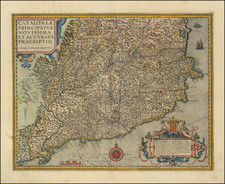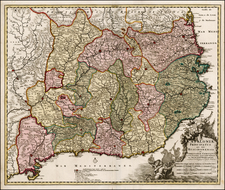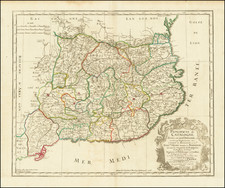The map provides a detailed portrayal of Barcelona and its surrounding suburban areas. Each district of Barcelona is thoughtfully numbered and differentiated by individual colors, creating a comprehensive and distinct image of the city's diverse neighborhoods.
The map includes prominent suburban districts such as Sarria, San Gervasio, Horta, Gracia, La Corts, Sans, Bordetta, Coll Blanch, Propriedad Guell, and Pedralbes. Each neighborhood is distinctly highlighted, demonstrating the diversity of the Barcelona metropolitan area, from its bustling city districts to the more tranquil suburban environs.
The map's scope extends from the mountainous regions in the north to the harbor in the south, encapsulating the geographical variety of the area. This gives viewers a perspective of Barcelona's varied landscapes, from the rugged, hilly terrains to the bustling port, providing context about the city's geographic location and the different lifestyles within its boundaries.
A significant feature of the map is the large inset that depicts the storefronts of the Los Grandes Almacenes El Siglo, located on Las Ramblas. This is more than a mere commercial highlight; it captures a snapshot of Barcelona's vibrant commercial life during the period. The store, a focal point in the city's shopping district, is indicative of Barcelona's robust commerce and the central role it played in city life.
In the early 20th century, the vibrant city of Barcelona experienced significant transformation and growth. From the late 19th century to the early 20th century, Barcelona emerged as a city of innovation and creative energy, reflecting the advent of Modernisme, Catalonia's Art Nouveau movement. This dynamic era in the city's history is subtly reflected in the map.
Around the turn of the century, the legendary architect Antoni Gaudí began the construction of the iconic Park Güell (Parc Guell), which was originally planned as a housing estate for the wealthy. Although the housing project was not fully realized, the park itself was completed and has since served as a symbol of the city's innovative spirit and Gaudí's unique architectural style. Its presence on the map, even as it was under construction, attests to the significant role it played in Barcelona's cityscape and cultural identity.
In addition to Park Güell, other iconic monuments that characterized this era are visible on the map. One such monument is the Casa Milà, another masterwork by Gaudí, completed in 1912. Also known as "La Pedrera" (The Quarry) due to its unconventional rough-hewn appearance, Casa Milà symbolized a break from traditional architectural norms and reinforced Barcelona's reputation as a city of architectural innovation.
Further, the map includes the bustling district of Las Ramblas, a vibrant cultural hub known for its marketplaces, cafes, and street performances. At the heart of this district stood the prominent storefronts of Los Grandes Almacenes El Siglo, one of the city's most popular department stores of the time. This grand commercial establishment catered to the city's growing middle class, embodying the economic prosperity of Barcelona during this period.
This comprehensive map, created circa 1910, reflects the rapid development of Barcelona from a local Catalan city into a metropolis of international significance. By highlighting key landmarks and the diversity of the city's districts, the map offers an invaluable glimpse into Barcelona's rich historical and cultural fabric during the early 20th century.














![[Barcelona] Barcino Metropolis Hispanici Principatus Cataloniae in littore Maris Mediterranei, perquam munita, et ab portus como ditatem celeberrimum Emporium cura Impensis . . .](https://storage.googleapis.com/raremaps/img/small/90953.jpg)
![[ Catalonia ] Accuratissima Principatus Cataloniae et Comitatuum Ruscinonis et Cerrataniae Descriptio . . .](https://storage.googleapis.com/raremaps/img/small/80899.jpg)
![Barcelona [with] Eciia](https://storage.googleapis.com/raremaps/img/small/96923.jpg)